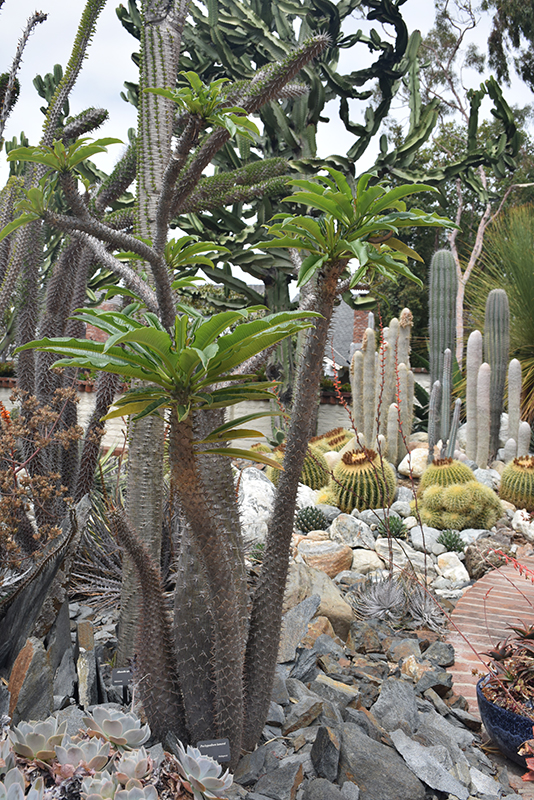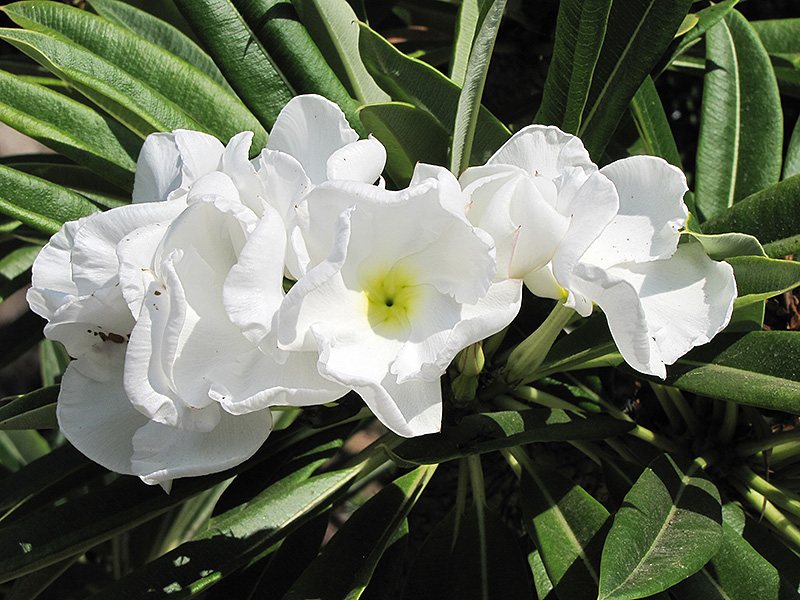
Plant Finder
Height: 20 feet
Spread: 10 feet
Sunlight:
![]()
Hardiness Zone: 10
Other Names: Pachy Palm
Description:
Despite its common name, this plant is a succulent in the plumeria (Apocynaceae) family; long, slender, dark green leaves surround the crown, shedding and emerging as the thorny stems grow upwards; a striking landscape or garden accent in frost free areas
Ornamental Features
Madagascar Palm is a highly distinctive and unusual plant. Although it actually isn't technically a cactus, it is still a succulent evergreen which behaves much like a cactus. It is characterized by the highly modified and distinctive spiny bulbous stems that comprise the bulk of the plant, and which are designed to retain water for extended periods of time. It has attractive dark green foliage with pointy creamy white spines. The glossy narrow leaves are highly ornamental and remain dark green throughout the winter. This plant features showy clusters of fragrant white star-shaped flowers with yellow eyes rising above the foliage from late winter to early spring.
Landscape Attributes
Madagascar Palm is an unusual succulent evergreen plant with an upright spreading habit of growth. It eventually becomes a spreading shrub-like plant with multiple 'branches' and stems. Unlike a cactus, which this plant resembles, it does have foliage, but it's the spiny bulbous stem structures that are of primary interest from a landscape or garden perspective.
This is a relatively low maintenance shrub, and should never be pruned except to remove any dieback, as it tends not to take pruning well. It is a good choice for attracting bees and butterflies to your yard, but is not particularly attractive to deer who tend to leave it alone in favor of tastier treats. Gardeners should be aware of the following characteristic(s) that may warrant special consideration;
- Spiny
Madagascar Palm is recommended for the following landscape applications;
- Accent
- Vertical Accent
- General Garden Use
- Container Planting
Planting & Growing
Madagascar Palm will grow to be about 20 feet tall at maturity, with a spread of 10 feet. It tends to be a little leggy, with a typical clearance of 4 feet from the ground, and is suitable for planting under power lines. It grows at a slow rate, and under ideal conditions can be expected to live for 60 years or more.
This shrub should only be grown in full sunlight. It prefers dry to average moisture levels with very well-drained soil, and will often die in standing water. It is considered to be drought-tolerant, and thus makes an ideal choice for xeriscaping or the moisture-conserving landscape. Like most succulents and cacti, this plant prefers to grow in poor soils and should therefore never be fertilized. It is not particular as to soil pH, but grows best in sandy soils. It is somewhat tolerant of urban pollution. This species is not originally from North America, and parts of it are known to be toxic to humans and animals, so care should be exercised in planting it around children and pets..
Madagascar Palm makes a fine choice for the outdoor landscape, but it is also well-suited for use in outdoor pots and containers. Its large size and upright habit of growth lend it for use as a solitary accent, or in a composition surrounded by smaller plants around the base and those that spill over the edges. It is even sizeable enough that it can be grown alone in a suitable container. Note that when grown in a container, it may not perform exactly as indicated on the tag - this is to be expected. Also note that when growing plants in outdoor containers and baskets, they may require more frequent waterings than they would in the yard or garden. Be aware that in our climate, this plant may be too tender to survive the winter if left outdoors in a container. Contact our experts for more information on how to protect it over the winter months.
This Plant Library is intended for informational purposes only, and is not an online store.


